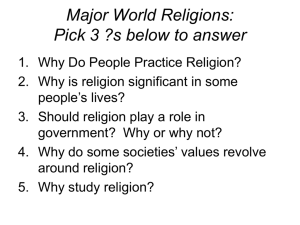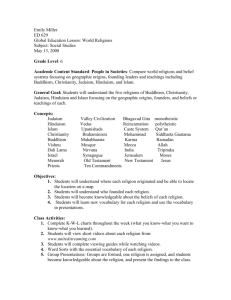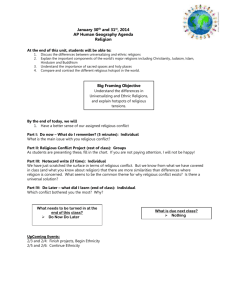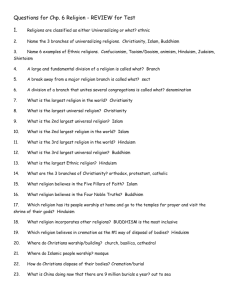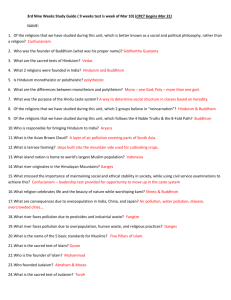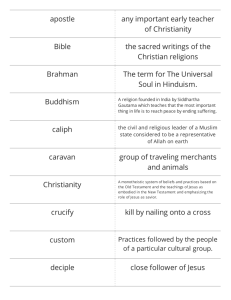How to study religions Belief systems
advertisement
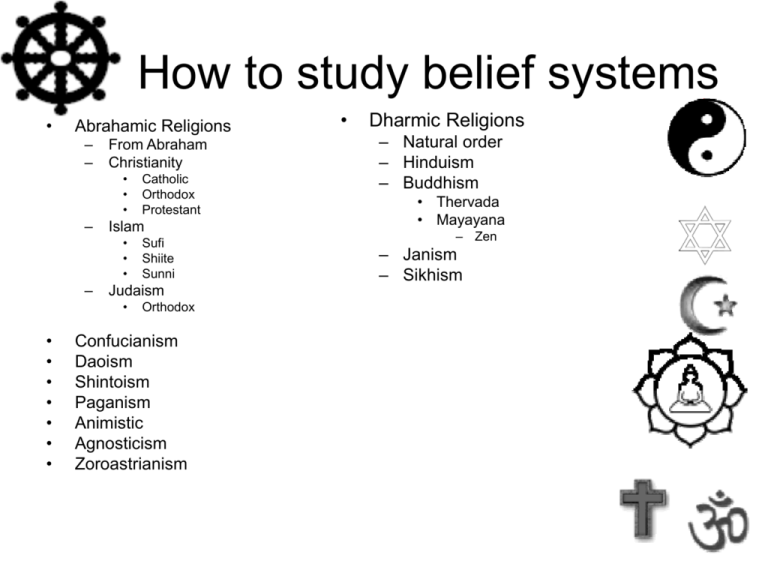
How to study belief systems • Abrahamic Religions – – From Abraham Christianity • • • – Islam • • • – Sufi Shiite Sunni Judaism • • • • • • • • Catholic Orthodox Protestant Orthodox Confucianism Daoism Shintoism Paganism Animistic Agnosticism Zoroastrianism • Dharmic Religions – Natural order – Hinduism – Buddhism • Thervada • Mayayana – Zen – Janism – Sikhism Religions Latin for tie back or reconnect “Theo” – mono, poly or pan “Non-Theo” – mystic (no personal god) Secular is indifferent to religions Spirituality or Sacred Religions – More than just a belief • How do we define religion • How do we classify religions – What are their characteristics – How do they evolve • Cultural character – Shrines, stupas, cathedrals, Grottos, monasteries • What is their political/social appeal • How do they interact – How do they travel – Conflict – Syncreticism Terms • Secular – Outside of religion • Asceticism – abstinence from worldly pleasures • Orthodox – Adhering to the accepted and traditional faith • Pious – Strictly adhering to the tenets of a religion • Tenets – teachings • Universal – – – – Categorize them adherents believe what they think is proper for ALL human kind have a means of transmission are not inextricably linked to a nation, ethnicity, or place are dominant somewhere • Ethnic – Simple – Complex – ethnicity and religion are joined such as Hinduism where you are born into the religion and it is your way of life • Syncretic – Blended together and forms a new religion • Exclusive vs.Non-exclusive – I’m right and you are wrong vs. whatever you want – Islam, Christianity, Judaism vs. Hinduism, Buddhism, • Pantheon – Polytheistic – many gods – Monotheistic – one god – Dualistic – pits equally evil gods against good gods • Schisms and divisions – Sects (Shiite vs. Sunni; Catholic vs. Protestant;Therevada vs. Mahayana) Classifying • Universalizing – Islam – Christianity – Buddhism • Syncretic – Janism • Hinduism & Buddhism – Sikhism • Islam & Hinduism – Neoconfucianism • Santeria (Lukumi, Regla de Ocha) • Vodoun (Voodoo) • Macumba (sometimes Quimbanda) and it's branches Umbanda and Candomble • Palo Mayombe • Ethnic – Hinduism – Shintoism – Judaism Tenets or teachings • How are they collected – Books of learning – Books of Law • Who does the teaching and where – Role of Monks & Monasteries • Actual foundation of the religion • • • • • How it spreads Pilgrims Trade routes Geographic conduits/crossroads/ obstacles Stages Conversion or forced acceptance – Exclusive or dual acceptance • Proselytizing –trying to convert someone to a religion • Mission (latin root is to send off) – duty to conduct such as Hajj • Diaspora Buddhism Christianity Hinduism Islam The spread of universal religions from 300-1500 CE Nature of Religion • Who are the leaders – What kind of background do they have • Degree of aggression • How are they organized – Hierarchy – Religious Institutions and bureaucracies • Connection with political authority Sacred sites and ceremonies • Meetings/gatherings • What types of structures • How are they connected to these sites geographically • Symbols of the religion Organization • • • • • Secular vs. Sacred Denomination Sect Cult Orthodoxy – Correct thought – Heresy is violation of the correct thought – Pious or Piety is to adhere or adhering to the tenets and orthodoxy of your religion Tolerance for other religions • Methods used to keep the true nature of their religion • Wars • Ethnic cleansing • Marriage • How do they convert others • Persecution Social roles • Gender roles • Exclusion or inclusion of others Details Dates, place and story of origin Prophet Messiah founder Places of worship Books of teaching and laws Basic teachings and beliefs Symbols Paganism • Gods as personification of nature • all living things have a spirit • Primal religion perceive and experience the cosmos as a sacred continuum in which nature is a ready and steady manifestation of spiritual realities Paganism • Continued in areas that had not been evangelized by Christianity and Islam • Shinto - Japanese spiritual presence or nature - worship of Kami (spirits) • (syncretic with Buddhism and some Confucanism) see on chart • Animism - worship of life forces • Totemism - identification of self with various animal symbols • Shamanism - belief in unseen spirit worlds • Druidic - based on Ancient Celtic practices • Wiccan - a creative force exists in the universe • Dreamtime - Aboriginies in Australia • Asatru - (Norse) Asatru- developed in Nordic countries and spread throughout northern Europe. Sweden had Asatru royality until around 1100. Re-established in the late 1800s. Corrupted by Nazi Party and continue use by Neo-Nazis. African Diasporic (Afro-Caribbean Syncretic) • History/Founder: – The origins of the Afro-caribbean sects (Known variously as Vodoun, Santeria/Lukumi, Candomble, Ifa, Palo Mayombe, etc.) are shrouded in the ancient past. Most were brought to the Americas by Yoruban slaves, (except for Palo, which is Bantu) who blended their tribal beliefs with Catholicism, spiritism, and even native belief. – Varieties of Yoruban descended religions are practiced in almost every country in the world. Most of the examples given in this guide conform mainly to Santeria/Lukumi beliefs, but there is a thread of commonality between all of them. • The most common of the syncretic faiths are: – Santeria (Lukumi, Regla de Ocha) – Vodoun (Voodoo) – Macumba (sometimes Quimbanda) and it's branches Umbanda and Candomble – Palo Mayombe • Current leader/governing body: – No central governing bodies. – Believers are largely autonomous, many consider themselves Catholic. Basic tenets • The area where these faiths differ most from one another is in sexuality, race, and gender taboos and rank. – – – – • Church/temple: – – • – – • None, most traditions are oral, and passed from teacher to initiate. Western books of ritual magick such as Goetia, or the seven books of Moses, are indispensable in some sects. Required observances, dietary restrictions: – • • Varies, usually space is consecrated outdoors before a ritual. Permanent temples or compounds, known as Peristyles in Vodoun, are also found in other branches- in Candomble, they are known as Terreiros. Scripture: – • In Santeria, women are forbidden from becoming Babalawos, and are sometimes restricted from practicing sacrifice, while in Candomble, women hold the highest positions in the faith, and are much more likely than men to head congregations. Homosexuality is also treated in very different ways- some sects of Palo, for example, prohibit homosexuals from membership, while most sects of Vodou are inclusive. Race is most often an issue in Vodou, where it has often been controversial. Many African sects will not initiate whites, while many Haitian and virtually all American sects are fully inclusive. Vary widely. Restrictions on dress and food consumption are common during rituals and while preparing for initiations. Many gatherings prohibit immodest dress, or the wearing of certain colors. For example, when one attends a terreiro, one must never wear red and black (unless, of course, one is attending an invocation of Exu). Some traditions require ritual sexual abstinence before initiation and on particular days. Basic teachings and Beliefs: Beliefs and practices vary widely from sect to sect and tend to be very complex, but all share some or all of the following traits: Syncretism or associations between traditional Yoruban or Bantu religion and Roman Catholicism, the practice of Animal sacrifice and trance possession, spirit mediumship, sympathetic magic, and elements of medieval Goetic magic and kabbalah. Dharmic • Hinduism • Buddhism – Ayrans – Karma • Vedic Era • Vedas • Polytheistic – Altman • Soul – Moksha • Liberation (from the cycle of reincarnation) – Scriptures • • • • • Vedas Upanishads Ramayana Mahabharata Bhagavad Gita – Dharma – Artha • Worldly gain – Kama • Sensual pleasure • Cause and effect – Dharma • Right behavior/true path – Therevada – Mahayana • Samsara – Suffering • Nirvana – Liberation • Bodhisattvvas – Humans who have reached Enlightenment and choose to stay in this world and not go to Nirvana • Eightfold Path • Zen – Lotus sitting and meditation • Temples of teaching and monks and monasteries in China, Korea, and Japan and less in South Asia and Southeast Asia Wise men don't need to prove their point; men who need to prove their point aren't wise. The Master has no possessions. Lao zi The more he does for others, the happier he is. Daoism focuses on wu wei or non action The more he gives to others, the wealthier he is. naturalness The Tao nourishes by not forcing. – (vitality and peace) keeps universe balanced, By not dominating, the Master leads. – Humanism Daoism • • • – emptiness is seen as refinement – If work against this emptiness then you upset the balance – The body coordinates with the elements • • Three Jewels - compassion, moderation and humility or kindness, simplicity and modesty Deities – Not really objects of worship – Jade Emperor – Three • • • Although historic roots appear around 6th century BCE or 4th to 3rd , it is officially recognized in the Tang Dynasty after the 7th Century CE. I’Ching or Book of Changes or Tao Te Ching Daozong or Treasury of Tao published during Ming dynasty How do Universalizing and Ethnic Religions Differ? Universalizing Ethnic •Appeal to people everywhere •Has meaning in particular place only. •Individual founder (prophet) •Unknown source. •Message diffused widely •Content focused on place and (missionaries) landscape of origin. •Followers distributed widely. •Followers highly clustered. •Holidays based on events in •Holidays based on local climate founder’s life. and agricultural practice. Classification • UNIVERSALIZING RELIGION -- one that attempts to appeal to all people, not only those at one location – adapt to almost any society – the religion itself sees no bounds to its eventual expansion over the entire landscape – Christianity, Islam, Buddhism • ETHNIC RELIGION -- religion with a spatially (socially or ethnically) concentrated distribution; principles of such a religion are likely to be based on physical characteristics of a particular location – stong territorial and cultural group identification – born into religion, religion and culture deeply intertwined – Judaism, Indian Hinduism, Japanese Shinto • Tribal or traditional religions – – – – small size, localized culture groups pre-modern societies close ties to nature animism, shamanism Role of Religion • a symbol of group identity and a cultural rallying point (like language) • both transmitters and identifiers of culture. • can influence the spread of languages to new peoples and areas (Arabic, Latin) • varies in its cultural role (unlike language); dominating to unimportant • a value system that unites and differentiates • religious when involving worship and faith in the sacred and divine • may involve prescribed patterns of behavior; prayer, special rites, obedience to doctrine Issues • Not a simple thing • “Being Religious” - Pious – Adhering to the tenets and beliefs of ones religion • Having a Pantheon or being monotheistic • If monotheistic details of who/what single deity is and what that deity requires of humans 1500BCE 1440 660 600 563 30CE 622 Major Religions of the World Ranked by Number of Adherents 1. 2. 3. 4. Christianity: 2 billion Islam: 1.3 billion Hinduism: 900 million Secular/Nonreligious/Agnostic/ Atheist: 850 million 5. Buddhism: 360 million 6. Chinese traditional religion: 225 million 7. African Traditional & Diasporic: 95 million 8. Sikhism: 23 million 9. Judaism: 14 million 10. Jainism: 4 million 11. Shinto: 4 million The Roots of Religion Animism (Shamanism) - the belief that all objects, animals, and beings are “animated” or possess a spirit and a conscious life. Also called shamanism because of the prominence of a Shaman. • Such beliefs are common among hunter- gatherers. • 10% of Africans follow such traditional ethnic religions. • These beliefs are losing ground to Christianity and Islam throughout Africa. Nigerian Shaman Animism • Retained tribal ethnic religion of people around the world • Today, adherents number at least 100 million • Animists believe certain inanimate objects possess spirits or souls – Spirits live in rocks, rivers, mountain peaks, and heavenly bodies – Each tribe has its own characteristic form of animism • A Shaman — tribal religious figure usually serves as the intermediary between people and the spirits Spread of Religions • imposed by conquest • adopted by conversion • defended and preserved in the face of surrounding hostility Cultural and Biological Exchanges Along the Silk Roads • The Spread of Buddhism and Hinduism Insert map on page 257 Religion and Fall of Classical Dynasties • The Fall of the Han Dynasty • Cultural Change in Post-Han China – Sinicization of Nomadic People • attempt to be influenced and assimilated by the Chinese culture (Korea, Japan later) – Popularity of Buddhism • Cultural Change in the Late Roman Empire – Prominence of Christianity – Formation of Institutional Church – Emergence of Pope POSTCLASSICAL ERA, 500 TO 1000 C.E Arabic to Islam Insert Chronology Chart on page 325 The Medinan Caliphate • The Problem of Succession • Abu Bakr (leader of prayers- companion and fourth convert) and Companions • Ali (cousin and adopted son of Muhammad, husband of Fatima, second convert) and Abbas (uncle of Ali and the Prophet) • The Medinan Caliphate • • • • (successor/representative) Abu Bakr (r. 632-634) ‘Umar (Omar ibn al-Khattab) (r. 634-644) ‘Uthman (Ummayyad clan) (r. 644-656) Ali (r. 656-661) • The Sunni-Shiite split Dar al-Islam • The Expansion of Islam – The Early Caliphs and the Umayyad Dynasty Insert map on page 310 States and Societies of Sub-Saharan Africa • Islamic Kingdoms and Empires – The Indian Ocean Trade and Islamic States in East Africa Insert map on page 436 India and the Indian Ocean Basin • Islamic and Hindu Kingdoms – The Quest for Centralized Imperial Rule India and the Indian Ocean Basin • Islamic and Hindu Kingdoms – The Introduction of Islam to Northern & Southern India • • • • The conquest of the Sind (711) Merging of cultures Sultanate of Delhi (1206) The Chola Kingdom (850-1267) India and the Indian Ocean Basin • The Influence of Indian Society in Southeast Asia – The Indianized States of Southeast Asia Insert map on page 372 Hinduism, Buddhism and Janism Dharmic religions Common Elements • Liberation is the central goal of all three of the Dharmic religions • Wheel of Life Comparisons • Of the regions most religiously active, India had by far the most activity. • While the Chinese philosophers focused more on how to live and left the hereafter for others to sketch in, the Indians covered both the seen and unseen worlds with their religious thought. • The times were prosperous, so that people could afford to turn their minds to otherworldly ideas. • None of these faiths form in response to something around them that is “wrong” but come into being out of contemplation, study, and realization. • They speak of harmonious relationships, not struggles; they have a tolerant, open message. • The Indian and Chinese ways are just that, “ways.” • They can be lived alongside other ways, or they can stand alone. • No pressure. • They do not exclude or feel a need to convince. Comparisons • By contrast, the Near Eastern and European religious movements arise out of seeing a “wrong” situation and wanting to correct it. • Moses, Zoroaster, Jesus, Muhammad, and others like them preach a message at odds with their surroundings and contain within their teachings a call to prostelyzation. • They develop out of times presenting a stark contrast and have a message asking people to choose the right side. Classical Hinduism • Focused on figuring out ways to break the continual cycle of rebirth, samsara • The particulars of an individual’s wanderings in samsara are determined by karma • Brahman: perfection, ultimate reality; eternal life force; only thing that really exists; “…is in all things, and is all things, is above all things.” All gods are manifestations (forms) of Brahman. • Maya: “magical spell”—a part of Brahman; the world we experience is an illusion (see, hear, feel, taste, smell, joy, pain: all maya) Hindu Temples Hinduism • Hinduism has splintered into diverse religious, some regarded as separate religions – Jainism — ancient outgrowth, claiming perhaps 5 million adherents • • • • Traces its roots back over twenty-five centuries Reject Hindu scriptures, rituals, and priesthood Share Hindu belief in ahinisa and reincarnation Adhere to a stern asceticism – Sikhism — arose in the 1500s, in an attempt to unify Hinduism and Islam • Centered in the Punjab state of northwestern India • Has about 19 million followers • Sikhs practice monotheism and have their own holy book, the Adi Granth Buddhism • Derived from Hinduism began 25 centuries ago • Reform movement grounded in the teaching of Prince Siddhartha — the Buddha • He promoted the four “noble truths” – – – – Life is full of suffering Desire is the cause of this suffering Cessation of suffering comes with the quelling of desire An “eight-fold path” of proper personal conduct and meditation permits the individual to overcome desire – Nirvana — reached when one has achieved a state of escape and peace, which is attained by very few Buddhism • Today the most widespread religion in Asia • Dominates a culture region from Sri Lanka to Japan and from Mongolia to Vietnam • Proselytes religion • Formed composite faiths as it fused with ethnic faiths especially in China and Japan • Fused with Confucianism, Taoism, and Shintoism • Southern Buddhism dominant in Sri Lanka and mainland Southeast Asia retains greatest similarity to original form • Special variation known as Lamaism prevails in Tibet and Mongolia Buddhism • Theravada Buddhism • Mahayana Buddhism Sects of Buddhism Theravada Mahayana • Traditional—religious life is a solitary individual journey (monk) • Reaching Nirvana is simply “ceasing to be” • Focus on meditation and personal perfection • Southeast Asia and Sri Lanka (Ceylon) • • • China, Japan, Korea, Tibet Belief in enlightened beings (bodhisattvas) who have perfected themselves to the point they are capable of leaving the cycle of death and rebirth because they have reached nirvana Bodhisattvas remain in human form to help others reach nirvana (perfect contentment, release of attachments, and release from cycle of death & rebirth) The Buddha Image The Buddha is the enlightened person, a role model to emulate not a god to try to please or placate Buddhist Temples Wat or Temple in Thailand Temple in Bhutan Gelugpa Temple, Mongolia Sacred space • Includes areas and sites recognized as worthy of devotion, loyalty, fear, or esteem – Notion occurs in many different cultures, past and present the world over – B.C. Lane says—”an ordinary place made extraordinary through ritual” – May be sought out by pilgrims or barred to members of other religions • Often contain the site of supposed supernatural events or viewed as abode of gods Sacred Space • Jerusalem is sacred space to Christians, Jews, and Muslims. It contains the Via Dolorosa (Way of the Cross) leading to the site of Christ’s crucifixion. • According to Jewish tradition, the sealed Golden Gate (far right) is where the Messiah will enter the city and bring redemption. Ruins of the City of David are at the southwest corner of the wall. Sacred space • Conflict can result of two religions venerate the same space • Example of conflict in Jerusalem – Muslim Dome of the Rock — site of Muhammad’s ascent to heaven – Wailing Wall — remnant of greatest Jewish temple • Cemeteries also generally regarded as type of sacred space Religious pilgrimage • Pilgrimages can have an economic impact, as a form of tourism • In some favored localities, pilgrim trade provides the only significant source of revenue – Lourdes — attracts between 4 and 5 million pilgrims each year • Many seek miraculous cures at its famous grotto where the Virgin Mary supposedly appeared • Ranks second only to Paris in number of hotel, and most are small – Mecca — attracts hundreds of thousand of Muslims • Come from every corner of the Islamic culture region • Closed to all non-Muslims Religion and lifestyle • This man is a Hindu sadhu or holy man. He has elected to remove himself from ordinary society to seek moksha or release from the cycle of birth, death, and rebirth. A devotee of Shiva, he hopes to achieve this ultimate state of bliss through a lengthy process of devotion, ritual, meditation and several rebirths. Mecca Mosque • Mosques differ widely in style yet their elements are constant. They include consecrated space for ritual prayer; a mihrab, or wall-niche indicating the direction (qiblah) of Mecca; and, to the right of the mihrab, a pulpit (minbar) for the Friday sermon. Mosques India Medina, Saudi Arabia Mombasa England Sudan Religious structures • In Islam, mosques are normally the most imposing items in the landscape • Jewish synagogues vary greatly in visibility • Hinduism has produced large numbers of visually striking temples, but many worship in private households Taj Mahal Landscapes of the dead • Christian cemeteries vary from modest, to places of color and elaborate decoration depending on the religious denomination • Cemeteries often preserve truly ancient cultural traits • Example of rural traditional cemeteries of the southern United States – Rose bushes planted atop the grave may derive from worship of an ancient, pre-Christian mother goddess of Mediterranean lands – Cedars planted on graves is an age-old pagan symbol of death and eternal life – Shell decoration derives from an animistic custom in West Africa Diffusion • • • • Expansion Hierarchical Contagion Relocation Religions of the Middle East Trace To A Common Ancestor Abrahamic Abraham Judaism 18 Million Christianity 2 Billion Islam 1.3 Billion The Semitic religious hearth • Christianity, Judaism, and Islam all arose among Semitic-speaking people • All three arose from the margins of the southwestern Asian deserts • Judaism, the oldest, originated about 4,000 years ago probably along the southern edge of the Fertile Crescent • Later, Judaism acquired dominion over lands between the Mediterranean and the Jordan River — territorial base of modern Israel The Semitic religious hearth • About 2,000 years later, Christianity arose as a child of Judaism from this same area • Islam arose about seven centuries later in western Arabia, partly from Jewish and Christian roots • Religions spread by both relocation and expansion diffusion – Expansion diffusion can be divided into hierarchical and contagious subtypes – Hierarchical diffusion — ideas are implanted at top of a society, leapfrogging across the map taking root in cities – Use of missionaries involves relocation diffusion Jewish Temple The Semitic religious hearth • Christianity spread through the Roman Empire using the existing splendid road system – Clearly reflected hierarchical expansion diffusion – Early congregations were established in cities and towns – Temporarily established a pattern of Christianized urban centers and pagan rural areas The Semitic religious hearth • Scattered urban clusters of early Christianity were created by relocation diffusion – Missionaries moved from town to town bearing news of the emerging faith – Missionaries often used the technique of converting kings or tribal leaders – Some expansion was militaristic — reconquest of Iberia, invasion of Latin America • Christianity spread farther by contagious diffusion, also called contact conversion Diffusion of Christianity • Tamils were brought to Malaya as indentured labor to work in mines and plantations during the colonial era. Many Hindu Tamils were of a low caste or even untouchables in India. Christianity, without proclaimed social divisions, was and remains attractive to downtrodden peoples. The Semitic religious hearth • Islamic faith spread in a militaristic manner – Followed the command in the Koran – Arabs exploded westward across North Africa in a wave of religious and linguistic conquest – Turks, once converted, carried out similar Islamic conquests – Muslim missionaries followed trade routes eastward to implant Islam hierarchically in the Philippines, Indonesia, and interior China Semitic religious hearth • Tropical Africa is the current major area of Islamic expansion • Diffusion successes in Sub-Saharan Africa and high birthrates in the older sphere of dominance has made Islam the world’s fastest-growing religion The lndus-Ganges Hearth • Second great religious hearth lies on the plains fringing the northern edge of the Indian subcontinent – Lowland, drained by the Ganges and Indus rivers – Gave birth to Hinduism and Buddhism The lndus-Ganges Hearth • Hinduism is at least 4,000 years old – Originated in the Punjab, from where it diffused to dominate the subcontinent – Missionaries later carried the faith in its proselytic phase, to overseas areas – Most converted regions were subsequently lost The lndus-Ganges Hearth • Buddhism began in the foothills bordering the Ganges Plain about 500 B.C. – For centuries remained confined to the Indian subcontinent – Missionaries later carried it to other countries and regions • China — between 100 B.C. and A.D. 200 • Korea and Japan — between A.D. 300 and 500 • Southeast Asia — between A.D. 400 and 600 – Tibet — A.D. 700 – Mongolia — A.D. 1500 – Developed many regional forms and died out in its area of origin Diffusion of Buddhism • Buddhism arrived with Asian migrants in the early 19th century and has become increasingly important with each subsequent immigrant group. • This is the Fo Kuang Shan Hsi Lai Temple in Hacienda Heights, an emerging Asian Suburban area near Los Angeles. Pilgrimage • Pilgrimages are journeys to especially sacred sites such as this monastery in the Himalaya mountains of Nepal; such pilgrimages often result from a vow and allow laypeople to reach a higher spiritual status Barriers and time-distance decay • Religious ideas weaken with distance from places of origin and time • Most religious barriers are permeable, but weaken and retard religious spread – Partial acceptance of Christianity by various Indian groups in Latin America and the western United States – Served as a camouflage under which many aspects of tribal religions survived – Permeable barriers are normally present in expansion diffusion Barriers and time-distance decay • Most religions become modified by older local beliefs as they diffuse spatially • Absorbing barriers — example of China – Christian missionaries to China expected to find fertile ground for conversion – Chinese had long settled the question of what is basic human nature – Believed humans were inherently good and evil desires represented merely a deviation from that state Barriers and time-distance decay – Evil desires could be shrugged off and people would return to the basic nature they shared with heaven – Christian idea of original sin left the Chinese baffled – Chinese could not understand the concept of humankind being flawed or their impossibility to return to godhood – Many concepts of Christianity fell on rocky soil in China – In the early twentieth century some Chinese became Christians in exchange for the rice missionaries gave them Barriers and time-distance decay • Religion can act as a barrier to the spread of nonreligious innovations • Religious taboos can function as absorbing barriers – Can prevent diffusion of foods and drinks – Mormons are forbidden to consume products containing caffeine – Some Pennsylvania Dutch churches prohibit cigarette smoking, but not the raising of tobacco by member farmers for commercial markets Religion and economy • Religion can also often explain the absence of crops or domestic animals in an area – Spain and Morocco show the impact of food taboos • On the Spanish, Roman Catholic side pigs are common • In Muslim Morocco only about 12,000 swine can be found in the entire country • Islamic avoidance of pork underlies this contrast – Judaism imposes restrictions against pork and other meats as stated in the Book of Leviticus Religion and economy • Other explanations for Islamic and Judaic pork taboos – Concern with the danger of intestinal parasites (trichinosis) – Considered pigs unclean – Unlikely relationship between poorly cooked pork and intestinal parasites would have been detected before modern medical technology – As some groups lost access to irrigation waters they became nomadic herders diffusion of Buddhism along the Silk Route • trade partly prospered because of the elaborate rites introduced into the practice of Buddhism in Central Asia. – The Stupas (icons) were wrapped with reams of silk on festive occasions thereby giving impetus to the silk trade in China. • The interlocking dome of the Stupas was to be the prototype for the domes over Mosques and churches that were built later by Romans and Arabs • The Dome of the Mosques in Islamic architecture is derived from the stupas • The hemispherical construction of Byzantine such as Haja Sophia of Byzantine has domes which reseble the Buddhist Stupa Relic Worships at Stupas • Relics are parts of the Buddha’s body (hair, nails, bones, teeth, etc.) that have great power and can bless those who worship them • Stupas are Buddhist temples that house a relic of the Buddha Asoka’s sponsorship of stupas Schisms or divisions Origin and Diffusion of Islam Taj Mahal • tomb & mosques – built by Shah Jahan – 5th Mughal Emperor – completed 1653 The Sacred Cow • • • • • • Nearly 200 million cattle in India Cow sacred and its slaughter forbidden 15% of world total Cows provide work, milk, ghee, dung, fertilizer Hinduism forbids slaughter of cows Goshalas – old age homes for old cows Lord Brahma: creator, continually making new realities Vishnu: Protector/Preserver AVATARS Krishna Rama Buddha the Caste System 4 Social Castes (Varna, subdivided into 1000s of jati) + outcastes – Brahmin (5% priestly & academic) – Kshatriyas (20% rulers, military, warrior) – Vaishya (farmers, merchants, landlords) – Sudras (laborers & artisans) • Untouchables (26% -- menial labor: slaughtering, cleaning) Dalit: Low-caste “untouchables” • 250 million out-castes • 1949 caste system outlawed • Oppression continues (rural areas) no rights for owning land or home no access to worship at the local temple no right to walk on certain roads segregated living severely impoverished suffer high levels of illiteracy • Since 1950s affirmative action Sikhism • Religion developed in Northern India as a result of the interaction of Hindus and Muslims. • Believe in reincarnation (Hindu) • Believe in one God (Islam) • Idea of moderation (combination of the two) Sikhism Symbols of the faith The Five K's: Clothing practices of stricter Sikhs: symbolize unity, truthfulness, faith, identity, justice – Kesa (long hair, never cut) – Kangah (comb) – Kacha (short pants) – Kara (metal bangle) – Kirpan (a ceremonial dagger) The Geography of Religion Ethnic Religions Universalizing Religions(proselytic) Polytheism Monotheism • 2 billion adherents make it most practiced in the world. •Originated in Bethlehem (8-4 BC) and Jerusalem (AD 30) with Jesus Christ. • Spread by missionaries and the Roman Empire (Constantine A.D. 313). • It is the most practiced religion in Africa today. Christianity Diffusion of Christianity • 1 billion + adherents • Originated in Saudi Arabia (Mecca and Medina) around AD 600. • Spread originally by Muslim armies to N. Africa, and the Near East. • Sunni (83%) throughout the Muslim world. • Shiite - Iran (40%), Pakistan (15%), Iraq (10%) Islam Holy Text: Koran Prophet: Muhammad • Five Pillars of Islam • There is one God and Muhammad is his messenger. • Prayer five times daily, facing Mecca. • The giving of alms(charity) to the poor. • Fasting during Ramadan for purification and submission. • If body and income allow, a Muslim must make a pilgrimage (hajj) to Mecca in his lifetime. • Islamic Calender • Begins in AD 622 when Muhammad was commanded to Mecca from Medina (Hijra). • Lunar calendar makes Ramadan move through the seasons (30 year cycle - 19 years with 354 days and 11 with 355). Sacred Site of Islam Diffusion of Islam Islam is considered the fastest growing religion in America. Only a small part of this growth is from black Muslims and the Nation of Islam. • 300 million + adherents Buddhism primarily in China and S.E. Asia • Originated near modern Nepal around 530 BC by prince Siddhartha Gautama. • Spread originally in India and Sri Lanka by Magadha Empire (250 BC). • Indian traders brought it to China in 1st century AD. • By 6th century it had lost its hold on India, but was now in Korea and Japan. Four Noble Truths: 1. All living beings must endure suffering. 2. Suffering, which is caused by desires (for life), leads to reincarnation. 3. The goal of existence is an escape from suffering and the endless cycle of reincarnation by means of Nirvana. 4. Nirvana is achieved by the Eightfold Path, which includes rightness of understanding, mindfulness, speech, action, livelihood, effort, thought, and concentration. Karma - your past bad or good actions determine your progress toward Nirvana through reincarnation. You are your own God. Buddhism Theravada - the older, more severe form which requires the renouncing of all worldly goods and desires. Mahayana - focuses on Buddha’s teachings and compassion. • 300 million + adherents primarily in China and S.E. Asia • Originated near modern Nepal around 530 BC by prince Siddhartha Guatama. • Spread originally in India and Sri Lanka by Magadhan Empire (250 BC). • Indian traders brought it to China in 1st century AD. • By 6th century it had lost its hold on India, but was now in Korea and Japan. Buddhism Hinduism • 900 million + adherents primarily in India • Hinduism is an ancient term for the complex and diverse set of religious beliefs practiced around the Indus River. • Reincarnation - endless cycles. Karma and Yoga. • Coastlines and river banks most sacred sites. • Vishnu and Shiva most common of hundreds of deities. Key Terms Syncretism - the mixing of two or more religions that creates unique rituals, artwork, and beliefs. Examples include syncretism of Christianity and indigenous beliefs in the Americas, Africa, and Asia. Voodoo Dolls, Haiti • Caribbean Voodoo (Haiti, Louisiana) • Christianity in Indigenous Latin American Shrine, Bangalore, India Syncretism - the mixing of two or more religions that creates unique rituals, artwork, and beliefs. Religious Conflict The Big Question: Can secular society exist alongside traditional and fundamentalist religious sects and states? • We are quick to notice fundamentalism abroad (i.e. Salman Rushdie’s death sentence by Shia clerics) and not so quick to recognize it at home (abortion clinic bombings; Southern Baptist Convention’s calls for women to submit to their husbands’ authority). • American evangelical Christianity and Islamic fundamentalism are the two most influential fundamentalist movements in the world. • Fewer and fewer states are governed by an official church. Role of Religion • • • • • How does it function in the society Who and what does it serve Can it be spread Does it promote the spread How does it impact change and stability in the society and in the world


